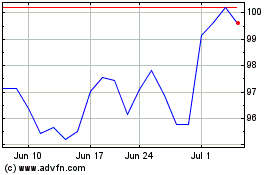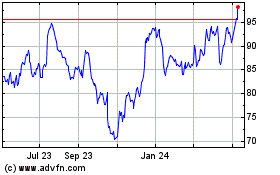Banking Brokers Boost Morgan Stanley's Wealth Unit
October 19 2016 - 12:47PM
Dow Jones News
By Michael Wursthorn
Morgan Stanley's wealth-management arm posted record quarterly
revenue, buoyed not by traditional brokerage activities but rather
by banking activities that underscore how big brokerages now lean
on brokers to collect deposits and push loans.
The New York bank said Wednesday that its wealth unit posted
$3.88 billion in third-quarter revenue, up 6.6% from the
year-earlier period. Brokers were able to get more clients to
deposit their money with Morgan Stanley and take out loans, pushing
the wealth unit's net interest income, or the difference between
interest earned and interest paid, up 18% to $885 million from last
year.
That helped offset a 2% decrease in asset-management fees, which
fell to $2.13 billion for the quarter due to a decline in the fees
it collects off of advisory accounts. Transactional revenue, which
includes commissions, was also up, but mostly because of investment
gains related to certain employee-deferred compensation plans, the
bank said.
"I don't think I've seen transaction levels lower than this,"
Chief Executive James Gorman told analysts on a conference call.
"The fact the [wealth] business had record revenue is a testament
to the managed-money side of it, the banking side of it, the
deposit side of it -- things that frankly 15 years ago didn't
exist."
Since the financial crisis, Mr. Gorman has put the brokerage
business at the bank's fore, favoring the steady revenue it
generates over harder-to-predict trading and investment-banking
activities. Morgan Stanley's initial step toward transforming
itself was in 2009, when it picked up thousands of brokers through
its acquisition of Citigroup Inc.'s Smith Barney brokerage
unit.
More recently, Mr. Gorman has turned his attention to boosting
the wealth-management unit's banking capabilities, an area in which
it lags behind rivals such as Bank of America Corp.'s Merrill
Lynch. Morgan Stanley started offering clients incentives to get
them to move more cash to their brokerage accounts, including fee
rebates for using automated-teller machines and free identity-theft
protection.
Morgan Stanley has also been trying to motivate its brokers to
help build up its bank, including offering bonuses of up to
$202,500 for getting clients to take out debt such as loans backed
by investment portfolios.
Deposits at Morgan Stanley have grown 7% from last year to $149
billion, while client loans surged 15% to $70 billion as of Sept.
30.
By comparison, Bank of America's global wealth unit, which
includes Merrill, for instance had $141.2 billion of total loans on
its balance sheet as of the end of the third quarter, while
deposits totaled $253.8 billion.
Morgan Stanley's approach to expanding its banking operations
has drawn scrutiny. Earlier this month, Massachusetts' top
securities regulator alleged in a complaint that Morgan Stanley
offices in Massachusetts and Rhode Island ran an internal sales
contest that gave brokers as much as $5,000 for signing up new
securities-backed loans in 2014, while playing down risks
associated with the products.
Morgan Stanley has objected to the allegations and said clients
consented to the loans after discussing the products with
brokers.
When asked about the complaint by an analyst, Mr. Gorman said it
won't force the bank to change its approach and declined to comment
further on the matter.
Despite Morgan Stanley's shift in focus, a trading rebound
contributed to a 57% jump in quarterly earnings.
Morgan Stanley hasn't disclosed detailed plans yet on how its
brokerage arm plans to comply with sweeping new rules on retirement
accounts that will hold brokers to a so-called fiduciary standard,
but Mr. Gorman said more information would be forthcoming in the
next few weeks.
Merrill Lynch is the only major U.S. brokerage to reveal how it
plans to comply with the rule, which require brokers to put the
interests of retirement savers first. Earlier this month, it said
it would abandon individual retirement accounts that charge
commissions.
Write to Michael Wursthorn at Michael.Wursthorn@wsj.com
(END) Dow Jones Newswires
October 19, 2016 12:32 ET (16:32 GMT)
Copyright (c) 2016 Dow Jones & Company, Inc.
Morgan Stanley (NYSE:MS)
Historical Stock Chart
From Mar 2024 to Apr 2024

Morgan Stanley (NYSE:MS)
Historical Stock Chart
From Apr 2023 to Apr 2024
